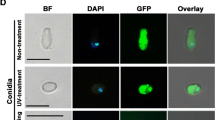Abstract
The organization of the actin cytoskeleton is of central importance in determining cell shape and morphogenesis. Rho-type GTP-binding proteins are known for their role to activate downstream effector proteins that act as scaffolds and direct the assembly of actin filaments. We have identified a novel Rho-type GTPase, RHOH, in the filamentous ascomycete Ashbya gossypii and also in one of its closest relatives, Holleya sinecauda both species belonging to the genus Eremothecium. RHOH is a paralog of AgRHO1 and was generated by tandem duplication in an evolutionary ancestor but is not found in Saccharomyces cerevisae. Deletion of RHOH was carried out in both A. gossypii and H. sinecauda and showed that this gene is non-essential. However, a cell wall defect was observed that led to increased cell lysis at the hyphal tip and an increased sensitivity against the cell wall agents calcofluor and SDS in the AgrhoH strain. These results suggested at least partially overlapping functions between RhoH and Rho1 without excluding any spilt functions of these proteins. Deletion of both the RHOH and RHO1 genes in A. gossypii exacerbated the mutant rho1 phenotype and resulted in germination deficient spores. This suggests that Rho1/RhoH -in contrast to Cdc42- are required at the early steps of spore germination.






Similar content being viewed by others
References
Adnane J et al. (2002) RhoB, not RhoA, represses the transcription of the transforming growth factor beta type II receptor by a mechanism involving activator protein 1. J Biol Chem 277:8500–8507
Berman J, Sudbery PE (2002) Candida Albicans: a molecular revolution built on lessons from budding yeast. Nat Rev Genet 3:918–930
de Bettignies G, Thoraval D, Morel C, Peypouquet MF, Crouzet M (2001) Overactivation of the protein kinase C-signaling pathway suppresses the defects of cells lacking the Rho3/Rho4-GAP Rgd1p in Saccharomyces cerevisiae. Genetics 159:1435–1448
Dietrich FS et al. (2004) The Ashbya gossypii genome as a tool for mapping the ancient Saccharomyces cerevisiae genome. Science 304:304–307
Dong Y, Pruyne D, Bretscher A (2003) Formin-dependent actin assembly is regulated by distinct modes of Rho signaling in yeast. J Cell Biol 161:1081–1092
Drubin DG, Nelson WJ (1996) Origins of cell polarity. Cell 84:335–344
Hall A (1998) Rho GTPases and the actin cytoskeleton. Science 279:509–514
Heinisch JJ, Lorberg A, Schmitz HP, Jacoby JJ (1999) The protein kinase C-mediated MAP kinase pathway involved in the maintenance of cellular integrity in Saccharomyces cerevisiae. Mol Microbiol 32:671–680
Kellis M, Birren BW, Lander ES (2004) Proof and evolutionary analysis of ancient genome duplication in the yeast Saccharomyces cerevisiae. Nature 428:617–624
Levin DE, Bartlett-Heubusch E (1992) Mutants in the S. cerevisiae PKC1 gene display a cell cycle-specific osmotic stability defect. J Cell Biol 116:1221–1229
Pruyne D, Bretscher A (2000) Polarization of cell growth in yeast. J Cell Sci 113(Pt 4):571–585
Reinoso-Martin C, Schuller C, Schuetzer-Muehlbauer M, Kuchler K (2003) The yeast protein kinase C cell integrity pathway mediates tolerance to the antifungal drug caspofungin through activation of Slt2p mitogen-activated protein kinase signaling. Eukaryot Cell 2:1200–1210
Schmidt A, Hall MN (1998) Signaling to the actin cytoskeleton. Annu Rev Cell Dev Biol 14:305–338
Steiner S, Wendland J, Wright MC, Philippsen P (1995) Homologous recombination as the main mechanism for DNA integration and cause of rearrangements in the filamentous ascomycete Ashbya gossypii. Genetics 140:973–987
Walther A, Wendland J (2004) Apical localization of actin patches and vacuolar dynamics in Ashbya gossypii depend on the WASP homolog Wal1p. J Cell Sci Pt 117:4947–4958
Wendland J (2001) Comparison of morphogenetic networks of filamentous fungi and yeast. Fungal Genet Biol 34:63–82
Wendland J, Philippsen P (2000) Determination of cell polarity in germinated spores and hyphal tips of the filamentous ascomycete Ashbya gossypii requires a rhoGAP homolog. J Cell Sci 113(Pt 9):1611–1621
Wendland J, Philippsen P (2001) Cell polarity and hyphal morphogenesis are controlled by multiple rho-protein modules in the filamentous ascomycete Ashbya gossypii. Genetics 157:601–610
Wendland J, Walther A (2005) Ashbya gossypii: a model for fungal developmental biology. Nat Rev Microbiol 3:421–429
Wendland J, Ayad-Durieux Y, Knechtle P, Rebischung C, Philippsen P (2000) PCR-based gene targeting in the filamentous fungus Ashbya gossypii. Gene 242:381–391
Zarzov P, Mazzoni C, Mann C (1996) The SLT2(MPK1) MAP kinase is activated during periods of polarized cell growth in yeast. Embo J 15:83–91
Acknowledgements
We thank Diana Schade for her excellent technical assistance in this project and Peter Philippsen for providing sequence data prior to publication. This research was supported by the Deutsche Forschungsgemeinschaft (grant We2634/2-1), the Friedrich-Schiller University, and the Hans-Knöll Institute.
Author information
Authors and Affiliations
Corresponding author
Additional information
Communicated by S. Hohmann
Rights and permissions
About this article
Cite this article
Walther, A., Wendland, J. Initial molecular characterization of a novel Rho-type GTPase RhoH in the filamentous ascomycete Ashbya gossypii . Curr Genet 48, 247–255 (2005). https://doi.org/10.1007/s00294-005-0017-2
Received:
Revised:
Accepted:
Published:
Issue Date:
DOI: https://doi.org/10.1007/s00294-005-0017-2




